BLOCK SCHEDULE: Teachers divided on AP viability
September 16, 2016
Editor’s Note: This is the second part of a series of articles about the 4×4 block schedule.
Teachers are split down the middle on the viability of AP classes in the 4×4 schedule system that is planned to be implemented next year.

“I’m pretty scared for next year,” AP English teacher Danielle Schafer-Cloke said. “There’s not a plan in place yet and I know that we started scheduling classes in January. That’s just a short few months away.”
With the planned 4×4 schedule, students would be taking classes over a semester that would typically be year-long courses. Students would take four classes a semester and meet every day for 90 minutes. This would extend the potential credits a student could earn in a four-year high school to 32 credits, excluding zero-period and other options. The schedule would also allow teachers a daily prep period, a contract requirement for the 2016-17 school year, and help students meet the state Core 24 credit requirements.
AP students take the AP test in May, raising concerns among parents that students won’t be able to retain the information if they take an AP class in the first semester. If an AP class is taken in the second semester, teachers are concerned with how they can fit in all the necessary curriculum before the test date.
“I’m concerned with retention in any schedule,” AP U.S. History teacher Brandon Harle wrote in a statement. “I currently am concerned about [covering all the AP curriculum] in our current schedule.”AP U.S. History (APUSH) teacher Brandon Harle pointed out that these concerns are universal to any schedule.
Harle’s APUSH course will run for three semesters next year; students will receive an additional half-credit for the class.
“I will have more time to teach. More consistency in daily schedule, more time to prepare students for success,” Harle wrote.
The Apple Leaf found, in a study conducted by The College Board, that students perform the best on average on AP exams for Calculus AB, Biology, English Literature, and U.S. History in year-long classes that meet for 30 to 60 minutes Monday through Friday.
The results suggest “that students, on average, obtain higher AP grades when instruction is given over an entire year rather than in a semestered block schedule format,” according to the study.

Individual schools boast contradictory numbers. Wayzata High School, the school in Minnesota that the WHS schedule committee visited to study the block schedule, took 1,738 AP tests in the 2014-15 school year with an 88 percent passing rate. WHS students took 407 AP exams last year with a passing rate of 59 percent passing rate in the same year. Wayzata’s APUSH course runs for three quarters, mirroring the plan for Harle’s class.
A report conducted by Hanover Research and provided by another individual on the schedule committee suggests that scheduling has a “negligible long-term effect” on achievement, instead placing emphasis on implementation.
“The success of a scheduling model in a specific school is largely dependent on several factors, including school demographics, proper training for teachers, and ‘thoughtful planning, organization, implementation, and evaluation’ of the scheduling model,” the study reads.
The study notes a major advantage of the block schedule is that it allows teachers to “employ a variety of instructional methods.”
For project-based classes, such as the AP Studio Art class taught by Don Collins, the block schedule is ideal.
“Any time we can have a block schedule with art, it makes a huge difference because kids have time to get set up and process what we’re doing in class,” Collins said. “We want a larger block of time with kids.”
When art classes were pushed into smaller periods, Collins said that it made it more difficult to work on projects in class.
“It was insane in here,” Collins said. “Kids were stressed out, they couldn’t finish projects, they could barely get started. I saw frustration.”
Other AP teachers are considered about the loss of total instruction time per class. According to the schedule committee, classes transitioning from year-long classes to semester classes will lose 10-15 percent of in-class time.

“It’s not about contact minutes, it’s about contact days,” AP Calculus teacher Randy Whited said. “They reduced our contact days to 150 contact days [with the current schedule]. It was a struggle to get our content into those days. With a semester, you’re looking at only 90 contact days. I can only put in so much information into those days. There’s no way I can teach everything in that short amount of time and be effective.”
With the 4×4 schedule, teachers would also have more time to dedicate to planning out their lessons, which math teacher and schedule committee member Tom Baumeister plans to use to adjust to the schedule. Baumeister does not currently teach any AP courses.
“I have to be introspective,” Baumeister said. “Now I have a whole prep period to figure out how to make it work… Are we going to be perfect the first year? I don’t think so. But we’re already doing block right now.”
*Table taken from a study conducted by Hanover Research

Jennifer Jorgensen • Sep 17, 2016 at 9:48 am
This is a thoughtful piece providing both the pros and cons of a 4×4 scheduled. I’ve been reading a fair amount on the subject as well as talking to teachers from across the country about this. I think the best solution may be a modified block schedule (which we already have) that allows for 7 year long classes (in lieu of 6). Trying to cover 8 classes per year dilutes the amount of time per class too much. You just can’t cover everything that needs to be covered in any class in so little time – that goes for AP classes as well as pre-algebra. We want our kids to pass classes the first time they take them so they have time for electives. I don’t see how cutting class time by so much will help them pass unless we lower our standards and cut content. The state requirement for graduation is only 24 classes so we really don’t need a schedule that provides 32 watered down credits. Although it sounds great to have APUSH for 90 min for 3/4 quarters, we can’t do that for all classes or the kids will only have 4 core classes per year with a few short electives for 4th quarter. It just doesn’t add up.
I agree that it is very important for teachers to have a prep period every day with any schedule. We don’t need to radically change the schedule to accomplish that.
Finally, I want to stress that we have time to think about this and come up with the best solution for ALL of our kids. The first class that will be affected by the change is the class of 2021, and our current schedule provides for the required 24 credits. So let’s take the time to investigate all of the possibilities. Let’s include parents, students and more teachers, not just a committee of 14 teachers and 2 adminstrators. Let’s be transparent about the process and work together on this.
Tyler Brown • Sep 17, 2016 at 12:27 am
Tyler Brown
Sophomore
When making schedules like these, it is important to take everything into consideration. Not only AP classes are affected, but any year-long classes that are actually meant to be year long are too. This 4×4 schedule messes with the people who take multiple year-lomg classes, like a music class or AVID. I am personally in band and AVID, and I plan on staying in both of those for the rest of my high school career EVERY year for both semesters. I am planning on pursuing a musical career and going to college, so both of these classes are very important to me. I think that the 4×8 schedule would not only be beneficial to year long elective students, but teachers who teach rigorous classes. It gives them more time, and it opens up a lot more opportunities for students. Some classes are just meant to be taught in a year round setting.